|
APRIL 2024
2023 member annual statements on their way in May
 Member annual statements for 2023, reflecting data submitted by your employer as of December 31, 2023, will be mailed by the end of May.
When you receive your statement, check that all of your personal information is correct. If not, contact your PERS-participating employer. If you are not currently employed by a PERS-participating employer, you can submit an Information Change Request form or request changes through Online Member Services (OMS).
All Tier One/Tier Two members who have worked in a qualifying position after January 1, 2004, have two parts to their PERS retirement: a pension and an Individual Account Program (IAP) account-based benefit. Both parts will be included on your statement.
Additionally, if you have an Employee Pension Stability Account (EPSA), that information also will be included on your statement. (Read more about EPSA in "Things to know about Member Redirect and your IAP" in this newsletter.)
Why send annual statements in May?
PERS cannot finalize 2023 statements until after the PERS Board adopts 2023 final earnings crediting, which occurred on April 1.
What resources can help me understand my statement?
Annual statement FAQs and resources are available on the PERS website, and the FAQ webpage is updated each year in spring.
Three key areas to review on your statement are:
-
Your birthdate and other personal information, such as your address, hire date, and membership date. Your birth date is used to establish which age-based target-date fund (TDF) your IAP is invested in.
-
Your service credit. Your years of service can affect the formula used to calculate your retirement benefits. Most Tier One and Tier Two members retire under the Full Formula Method.
-
Your IAP information. This area shows you the investment returns for your target-date fund. Each fund has its own mix of investments, set by the Oregon Investment Council. Your investment returns may differ from other members who are in different TDFs.
|
|
We want to hear your thoughts about PERS

The PERS annual Member Satisfaction Survey is coming next month. Share your feedback and help PERS, the agency, improve our member services.
Starting May 1, you can complete the survey online. PERS will send a reminder about the survey once it's available.
You will have until May 31 to complete the online-only survey.
|
|
|
Member Choice: If you opted to change your TDF ...

Any changes you made to your Individual Account Program (IAP) target-date fund (TDF) by September 2023, took effect on January 1, 2024, and you cannot make any new changes in Online Member Services until the next Member Choice window in September 2024.
Changes that took effect in January will not be reflected on the member annual statement you receive this spring because the cut-off date for account information that goes into your statement was December 31, 2023. You will see January 2024 changes on your spring 2025 statement.
Find full information about Member Choice on the IAP target-date funds webpage.
|
|
|

If you earn more than the annually adjusted monthly salary threshold, a portion of your 6% IAP contributions is now redirected into your Employee Pension Stability Account (EPSA). EPSA contributions and earnings from 2023 will be shown on your 2023 member annual statement, which you will receive in spring 2024. The redirect to EPSA remains in effect when the PERS system is less than 90% funded*.
To offset the redirect, you can opt to make a post-tax 2.5% voluntary contribution to your IAP or consider increasing your retirement savings elsewhere, such as with the Oregon Savings Growth Plan (OSGP). Remember that you can begin or end voluntary IAP contributions by logging into your Online Member Services (OMS) account.
Find full information about Member Redirect on the IAP redirect webpage.
*The latest actuarial valuation shows that PERS’ funded status including side accounts was 79% as of December 31, 2022.
|
|
|
Salary limit increased for benefit calculations

In January 2024, the limit on subject salaries used in benefit calculations increased to $232,976* per year.
PERS uses subject salaries to determine member IAP contributions, employer contributions to fund the pension program, and the final average salary for calculating retirement benefits under formula methods.
If you plan to retire in the first few months of 2024, be aware that salary limitations also apply to working partial years. Read more about Senate Bill 1049 salary limits and partial year salary limits online.
*Indexed annually to the Consumer Price Index
|
|
|

Your retirement future is up to you. How you plan and save for your retirement can determine your retirement security.
To check whether you’ll have the money you need for a secure retirement, begin by gathering benefit estimates for your retirement accounts and Social Security. Two available estimation tools are:
Add up your estimates and compare your total to what financial experts say you’ll need when you retire: 80% of your working income.
If your total estimate falls short, you may consider saving additional money in other retirement accounts.
One option for saving more is the Oregon Savings Growth Plan (OSGP). OSGP offers both pre- and post-tax retirement savings options and various free educational workshops. Check with your employer to see if OSGP or other voluntary retirement savings options are available to you.
|
|
|

Preparing for retirement requires many steps — from estimating whether you’re saving enough to designating beneficiaries as applicable to your membership type.
Something else to plan for is who will act on your behalf in the event of severe illness or death. Check out these resources:
-
Authorization to Release Account Information* — This form will allow you to name other parties who can receive information about your PERS benefits, including account balances and benefit estimates.
-
Special Power of Attorney for PERS* — This form will allow you to designate others who can make decisions about your PERS benefits on your behalf.
Also be aware that when you die, a family member, beneficiary, or caregiver must notify PERS. More information about member deaths and death benefits is available on the PERS website.
*Note that the account information release and special power of attorney (POA) forms are only valid while the member is alive. You can cancel the release and special POA at any time.
|
|
|
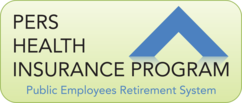
As you ponder your future retirement, don’t forget about health care.
Many public employees have the majority of their health insurance costs covered by their employers while they are still working. In some cases, employers may cover up to 99% of medical, dental, vision, and basic life insurance premiums. When you stop working, the cost of your insurance coverage will rest solely with you.
Depending on your age and other factors at retirement, you may or may not yet be eligible for Medicare coverage. Even when you are eligible, Medicare does not cover all health care costs, and you may wish to have supplemental coverage to bridge the gap.
Once you become a PERS retiree, several health insurance options will become available to you through the PERS Health Insurance Program (PHIP). PHIP offers Medicare and non-Medicare plans, as well as dental options.
Visit the PHIP website or call 800-768-7377 for more information about the program.
Additional information about health care coverage and costs
- Some industry estimates say the average health care costs in retirement amount to hundreds of thousands of dollars.
- Estimator tools can help you explore possible health care costs. Fidelity, a financial services corporation, offers one such tool. This tool is for general information only and not a guarantee of future costs.
- If you have questions about Medicare, check out the Oregon Senior Health Insurance Benefits Assistance (SHIBA) program. SHIBA offers certified, local counselors who can help.
|
|
|

Are you planning to retire in the near future? Don’t wait until the last minute to prepare.
Check out these helpful resources from PERS to get ready:
Also, keep the following important points in mind:
- Retirement applications may be submitted to PERS within 90 days of your retirement day.
- It can take up to 92 days from your retirement date (not the date of your application submission) for your first pension benefit to be paid.
- Once PERS receives your application, we will review your account information and reconcile data with your employer(s) as needed. Data discrepancies can sometimes cause your finalized benefit amount to differ from benefit estimates you received earlier. Remember that benefit estimates are just that — estimates.
- Filling out your application correctly, checking your personal information in OMS or on your member annual statement, requesting benefit estimates, and responding to requests from PERS for additional information can help you avoid delays in the processing of your application. If you are working for a PERS-participating employer and find errors in your personal/account information, contact your employer for corrections. If you are not working for a PERS-participating employer, read the inactive member section on our Change your address webpage for instructions.
-
Individual Account Program (IAP) retirement benefits can typically take from 90 to 120 days to process and complete payments or rollovers. Processing is done both by PERS and Voya, which administers IAPs for PERS.
- If you are purchasing time, contact PERS to make sure your payment was received — whether you mailed a check or used a trustee-to-trustee transfer to make the purchase.
If you have questions, contact Member Services for assistance.
|
|
|
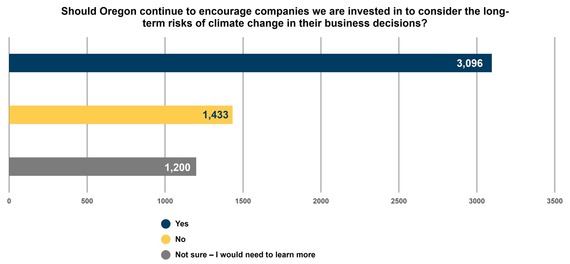 Oregon State Treasury surveyed PERS members in 2023 to get feedback on how Treasury is managing PERS investments. This graphic shows the results to a survey question about investments and climate change. (Graphic courtesy of Oregon State Treasury)
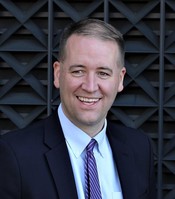
By Tobias Read
Oregon State Treasurer
Earlier this year, Oregon State Treasury released its plan for transitioning the Oregon Public Employees Retirement Fund (OPERF) to a net-zero carbon emissions portfolio by no later than 2050.
Guided by our responsibility to beneficiaries of the state retirement system, my team and I worked to develop a responsible net-zero transition plan for OPERF that will allow the fund to continue to deliver strong returns for members now and in the future.
Recognizing the importance of taking action to address the investment risks related to the global climate crisis, our goal during the plan’s development was to position the pension for the future.
Treasury has long been on a path to better understand and act on the risks of climate change, both through public-facing efforts as a responsible investor and in the behind-the-scenes work our staff engages in daily while managing our investment portfolio.
This plan came together thanks to the tireless and sincere engagement of people inside and out of Treasury.
We took several steps to identify the best strategy to move the portfolio to net zero by 2050, including:
- Developing guiding principles that put PERS members first.
- Completing a thorough analysis of OPERF to establish baseline emissions measurements.
- Exploring the feasibility of different pathways to decarbonize the portfolio.
- Engaging with PERS members, such as through our pension feedback survey last year.
I want to again extend my appreciation to PERS members who participated in our survey. Your time and responses provided our team at Treasury with valuable feedback.
Over the next several years, Treasury plans to begin implementing emission reduction strategies, while maintaining target returns and avoiding portfolio disruptions.
I invite you to visit the Treasury website to read more about the net-zero transition plan on our Sustainable Investing webpage.
|
|
|
Survey insights from PERS members help Treasury
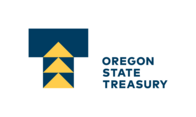
By Oregon State Treasury
Oregon State Treasury invited PERS members last year to complete an online survey about Treasury’s management of pension fund investments.
With cooperation from PERS, the agency, and direct outreach from Treasury, the survey was shared with thousands of active and retired PERS members from state and local governments across Oregon.
This engagement effort yielded more than 5,800 responses* — providing insights into members’ investment preferences, overall understanding of our state’s pension system, and interest in learning more about how Treasury manages your retirement funds.
Obtaining PERS members’ feedback was a core component of Treasury’s efforts to develop and implement a responsible net-zero transition plan for the Oregon Public Employees Retirement Fund (OPERF).
The plan was published earlier this year on the Treasury website.
Survey highlights include:
- “Manage short- and long-term risks to investments to generate sustainable investment returns” was chosen by more than half of survey takers as the most important aspect of how Treasury manages PERS members’ retirement savings.
- About a third of survey takers said they wanted Treasury’s management to generate the highest possible investment returns for current and future retirees.
- More than half of survey takers who responded to the question “Should Oregon continue to encourage companies [in which OPERF is invested] to consider long-term risks of climate change in their business decisions?” answered “yes.”
Treasury looks forward to continuing to provide updates in the future about its investment practices and the management of your retirement savings.
(*61% of survey responses came from nonretired members and 39% from retired members.)
|
 Oregon State Treasury surveyed PERS members in 2023 to get feedback on how Treasury is managing PERS investments. This graphic shows what survey takers thought were the most important approaches when it comes to how Treasury manages PERS investments. (Graphic courtesy of Oregon State Treasury)
|
|

The Oregon Public Employees Retirement Fund (OPERF) earned 5.98% in investment returns for 2023.
However, annual earnings credited to member accounts will be different than this rate. They differ because of administrative expenses and various requirements set by state law, administrative rules, and PERS Board actions.
The board approved the 2023 annual earnings crediting to member accounts at its April 1, 2024, meeting. You can find the rates credited to various accounts on the 2023 earnings crediting webpage. The accounts include Tier One/Tier Two regular accounts, the Individual Account Program target-date funds, and Employee Pension Stability Account.
The 2023 earnings credited to your accounts will be reflected in your upcoming 2023 member annual statement. You should receive this statement by the end of May.
OPERF is managed by Oregon State Treasury under the direction of the Oregon Investment Council (OIC).
|
|
|
|
As a PERS member, you may wonder how your pension system keeps track of its financial health.
Each year, PERS calculates its “funded status,” which compares projections of how much money the PERS system will have versus how much it is expected to pay out in retirement benefits within a certain timeframe.
To calculate the funded status, PERS follows a process called an “actuarial valuation.”
The latest actuarial valuation* shows that PERS' funded status is 79% as of December 31, 2022. This valuation includes funding from employer sources known as “side accounts.”
Every two years, the PERS Board examines how much money is coming into the system through employer sources. Based on the actuarial valuation and other data, the board decides whether to change employer contribution rates (C) to ensure that money coming into the system — along with projected earnings from investments (E) — will be enough to cover benefit payments (B).
On the earnings side, about 73% of benefit payments since 1970 have been paid for by long-term investments in the Oregon Public Employees Retirement Fund (OPERF).
*The next actuarial valuation will be for the year ending December 31, 2023. It will be released in fall 2024.

|
|
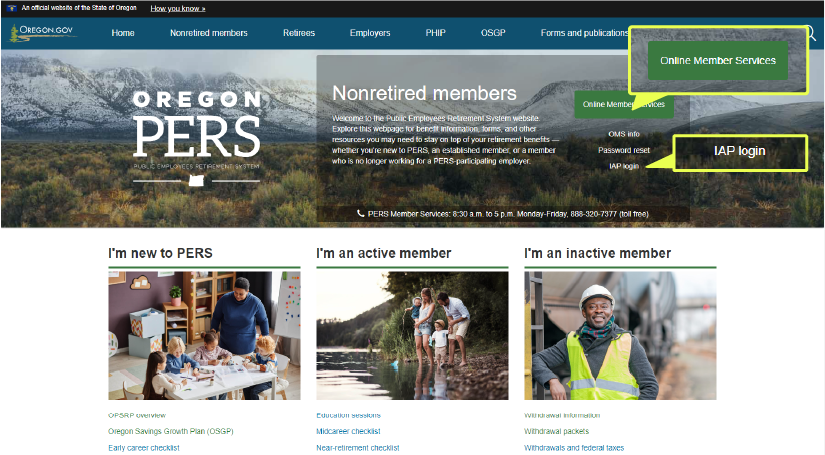 You can access logins for Online Member Services (OMS) and the Individual Account Program (IAP) from the webpage for nonretired members.
Need to check your service credit, register for an education session, or update your address or contact information? PERS has you covered with a number of self-service tools.
Online Member Services
Online Member Services (OMS) is where to go to:
- Review your employment history, including your salary and service credit.
- Generate online benefit estimates for your pension.
- Check your contact information, including your address, email, and phone number. You can update your email and phone information yourself in OMS. Your address is submitted by your employer, and you will need to contact your employer to update it.
-
Begin or end voluntary contributions to your IAP.
If you need to set up an OMS account, check out our What is OMS? webpage.
Individual Account Program (IAP)
Use the Individual Account Program (IAP) portal to check information about your IAP account, such as your IAP balance and ongoing contributions.
Note that employer reporting cycles and other factors can sometimes delay updates to your IAP information from being displayed in the IAP portal.
And if you’ve never logged into your IAP before, you’ll need to contact Member Services to request an initial login PIN. Further details can be found on PERS’ IAP account log-on information webpage.
Oregon Savings Growth Plan (OSGP)
Do you want to save more for retirement? Learn how you could supplement your retirement savings through the Oregon Savings Growth Plan (OSGP).
Find your forms
Want to designate your beneficiary, request a benefit estimate, or apply for retirement? There’s a form for that.
Find the form you need on PERS’ Most requested forms and Tier One/Tier Two forms webpages.
When retirement nears
If you’re close to your desired retirement age, it’s time to review the steps you need to take to retire.
PERS recommends you start these preparations early to avoid delays in your retirement process. Preparations should include getting online or written benefit estimates of what your pension payments could be and participating in a PERS education session.
Post-retirement health plans
How will your health care needs be covered in retirement? Learn about Medicare and non-Medicare plans and options for supplemental medical and dental insurance through the PERS Health Insurance Program.
|
|

PERS will not make unsolicited calls to you and will never ask you for account login or financial information.
PERS will only contact you in response to a request you made, a form you submitted, or another action you took. If you are unsure whether someone contacting you is from PERS, call Member Services directly at 1-888-320-7377 to check.
Read more on our Protect yourself from fraud webpage.
|
|
|
 |
|
Stay informed with PERS email or text updates |
|
|
You can get alerts on topics that include:
- Member news
- PERS Health Insurance Program
- Legislation affecting members
- PERS Board meetings
- PERS administrative rulemaking
|
|
|
Mailing address:
PERS
PO Box 23700
Tigard, OR 97281-3700
Physical address:
11410 SW 68th Parkway Tigard, OR 97223
Phone: 888-320-7377
TTY: 503-603-7766
Phone lines open 8:30 a.m. to 5 p.m. Monday through Friday, except holidays.
|
|
We serve the people of Oregon by administering public employee benefit trusts to pay the right person the right benefit at the right time.
Chair: Sadhana Shenoy
Vice Chair: Stephen Buckley
Members: Jardon Jaramillo, John Scanlan, and Suzanne Linneen
Director: Kevin Olineck
Deputy Director: Yvette Elledge-Rhodes
Chief Financial Officer: Richard Horsford
Chief Information Officer: Jordan Masanga
Chief Compliance, Audit, and Risk Officer: Jason Stanley Chief Operations Officer: Sam Paris
For more information contact:
PERS | PHIP | OSGP
|
|
|
Perspectives is published by the Oregon Public Employees Retirement System for the benefit of members and employers. It is emailed three times a year.
|
|
|
|
|